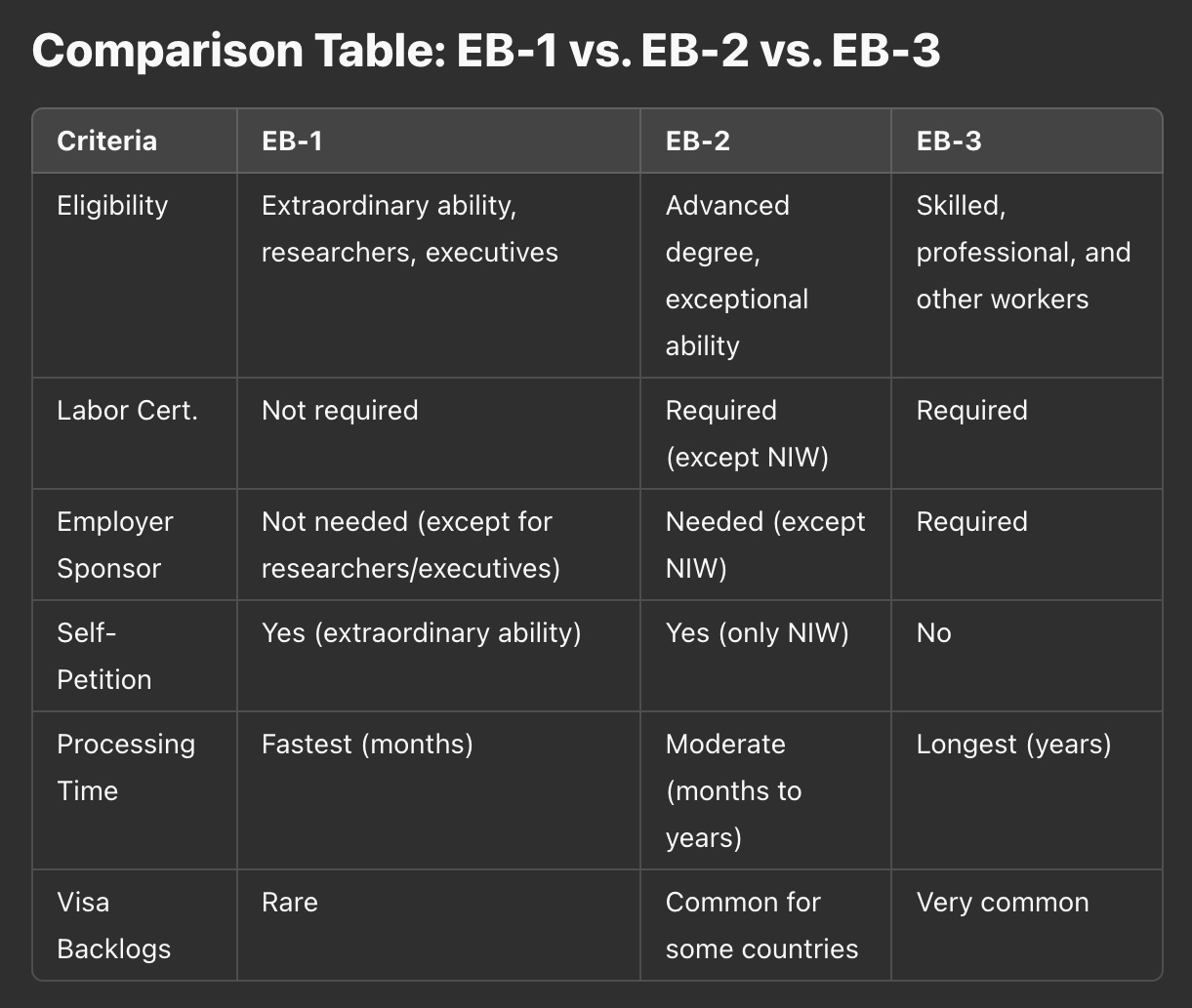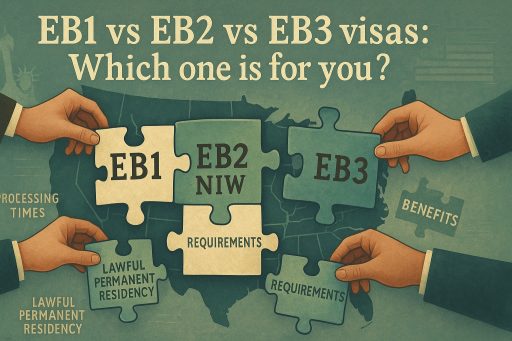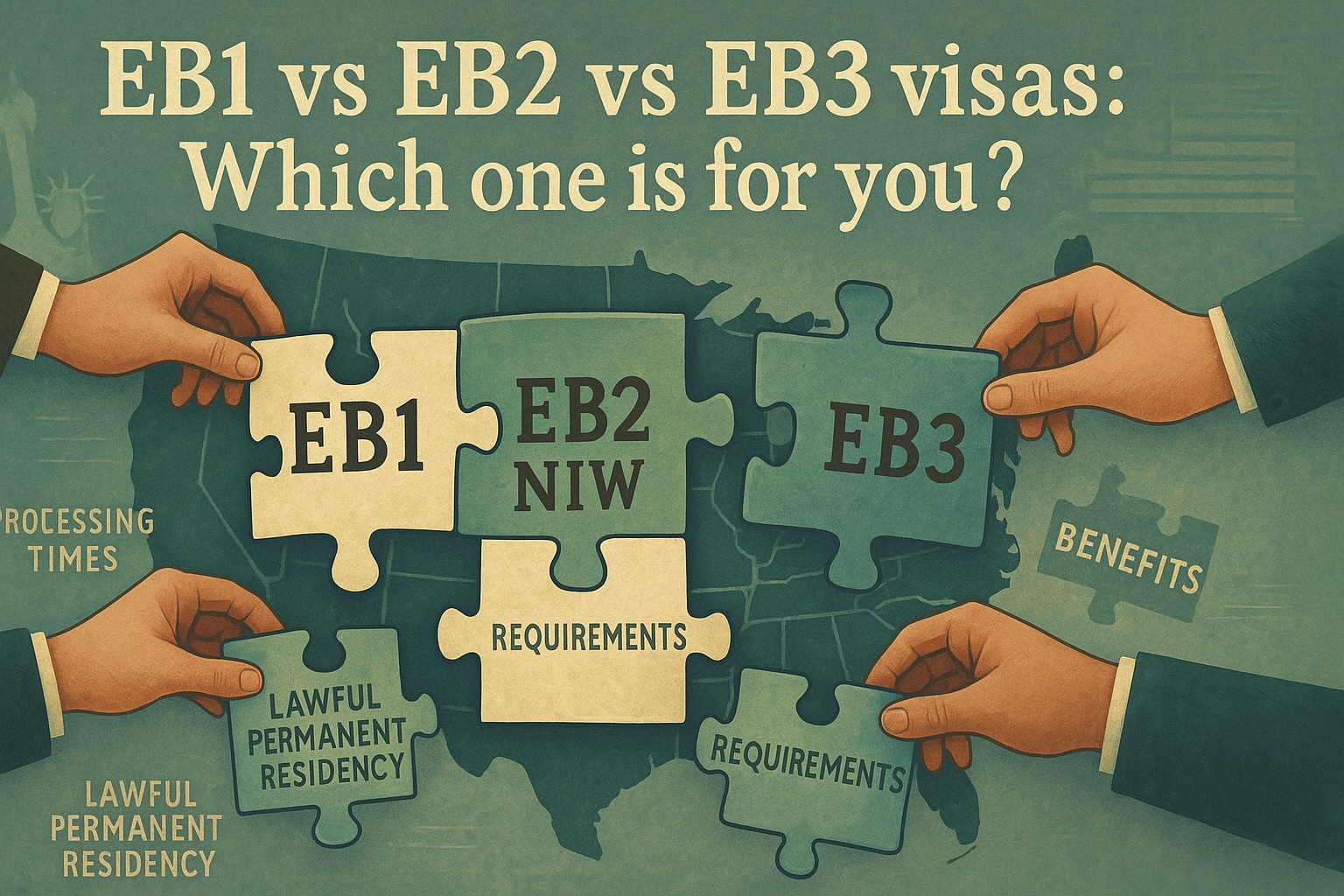EB1 vs EB2 vs EB3 visas: Which one is for you?
The U.S. offers several employment-based (EB) visa options for foreign professionals. The three most common are EB1, EB2, and EB3. Each has different requirements, processing times, and benefits. Understanding these differences helps you choose the right path for your immigration journey.
What are EB1, EB2, and EB3 visas?
The EB1, EB2, and EB3 visas provide employment-based options for foreign nationals to gain lawful permanent residency. Each designed for different professional groups with distinct requirements.
EB1: Choice for the most accomplished
EB1 is the most prestigious employment-based visa category for individuals with extraordinary ability, leading researchers, and managers and executives working for multinational corporations.
One key advantage of the EB1 category is that it does not require labor certification. This makes the process much faster. Additionally, individuals with extraordinary ability can self-petition, meaning they do not need an employer sponsor. Researchers, as well as multinational managers and executives, must have an employer submit the application on their behalf.
EB1 has generally shorter processing times compared to EB2 and EB3, making it appealing to highly qualified professionals.
However, the EB1 category has strict application requirements and a high burden of proof. Applicants must provide extensive documentation, such as evidence of internationally recognized awards, significant media coverage, and published work. The stringent eligibility criteria make this visa difficult to obtain, even for highly skilled professionals.
EB2: For advanced degree holders and exceptional talent
EB2 is for professionals with advanced degrees or individuals with exceptional ability in sciences, arts, or business. The EB2 category has two options. One requires a PERM labor certification process. The other, the EB2 NIW self petition, lets applicants skip this step.
A key aspect is the National Interest Waiver (NIW). Applicants show that their work has substantial merit and national importance. They also provide evidence that they are well positioned to advance their endeavor. Finally, NIW applications need to prove that waiving the job offer and labor certification would benefit the United States.
It allows applicants to self-petition for a green card through the EB2 NIW I 140 process. This means they do not need an employer sponsor or labor certification, making the process faster and more flexible.
EB2 has less stringent requirements than EB1. Dedicated for professionals with strong above average expertise who don’t meet the extraordinary ability standard. However, processing times for EB2 vary widely depending on labor certification requirements and visa availability.
Applicants seeking an EB2 NIW green card may face delays because of country-specific visa backlogs. Although EB2 NIW skips labor certification, the overall wait time depends on visa availability for the country of birth.
When comparing EB2 vs EB3, the key difference lies in criteria and processing times. EB2 requires an advanced degree or exceptional ability. EB3 is available to skilled and some unskilled workers with a valid job offer.
EB2 also offers the National Interest Waiver (NIW), which lets applicants bypass labor certification. In contrast, EB3 requires both an employer sponsor and labor certification, making the process longer.
EB3: For skilled, professional, and other workers
EB3 is the most accessible employment-based visa category but also has the longest waiting periods.
The main advantage of EB3 is that it has less stringent requirements. Skilled, professional, and some unskilled workers qualify with a valid U.S. job offer. Unlike previously discussed visas, EB3 requires only two years of experience in a trade or a bachelor’s degree.
However, EB3 comes with certain limitations. Labor certification and employer sponsorship are mandatory, which adds additional time and complexity to the process. Additionally, high demand for EB3 visas causes long wait times, especially for applicants from oversubscribed countries. As a result, processing times for EB3 are typically much longer than for EB1 or EB2.
Comparison table: EB1 vs EB2 vs EB3
- Criteria: EB1, EB2, EB3
- Requirements: Extraordinary ability, researchers, executives; Advanced degree, exceptional ability; Skilled, professional, and other workers
- Labor Certification: Not required; Required (except NIW); Required
- Employer Sponsor: Not needed (except for researchers/executives); Needed (except NIW); Needed
- Self-Petition: Yes (extraordinary ability); Yes (only NIW); No
- Processing Time: Fastest (months); Moderate (months to years); Longest (years)
- Visa Backlog: Rare; Common for some countries; Very common

Understanding the difference between EB2 vs EB1 is essential for those choosing the right category for a self sponsored green card. EB1 is for individuals with extraordinary ability, while EB2 is more accessible to professionals with advanced degrees or exceptional ability. EB1 has faster processing but requires stronger evidence to qualify.
Choosing the right category
The best category depends on your expertise and career goals.
For those with internationally recognized achievements, EB1 is the fastest and most reliable option since it bypasses labor certification. However, its strict eligibility criteria make it a difficult category to qualify for.
EB2 is a strong choice for professionals with an advanced degree or exceptional ability. The self petition EB2 NIW option offers greater flexibility for those who can demonstrate significant contributions to the U.S. However, processing times can be long, particularly for applicants from high-demand countries.
For those who don’t qualify for EB1 or EB2, EB3 is an option if they have a U.S. employer sponsor. However, it involves longer wait times and requires labor certification.
Processing times and green card availability
Processing times vary significantly between categories. EB1 is generally the fastest, followed by EB2 and then EB3. However, visa availability and country-specific limits play a crucial role in determining actual wait times.
Several factors impact processing times:
- The USCIS case load and processing speed.
- The applicant’s priority date, which determines when a visa becomes available.
- The time required for labor certification, which applies to EB2 (except NIW) and EB3.
- The applicant’s country of birth, as individuals from high-demand countries often face backlogs.
Tips for a successful application
A well-prepared petition letter package is essential for a strong application. Petitioners should gather strong supporting documentation, including academic records, letters of recommendation, and proof of professional accomplishments.
Check the U.S. Department of State’s monthly Visa Bulletin for updates on visa availability and priority date movements.
Final thoughts
Each employment-based visa category has its advantages and challenges.
EB1 is ideal for highly accomplished individuals who meet strict requirements. EB2 offers a flexible path for those with advanced degrees or exceptional ability. Especially convenient if their work is beneficial to the United States. EB3 is an option for skilled and professional workers but has the longest processing times.
Understanding these differences helps visa applicants make informed decisions about their immigration journey.














